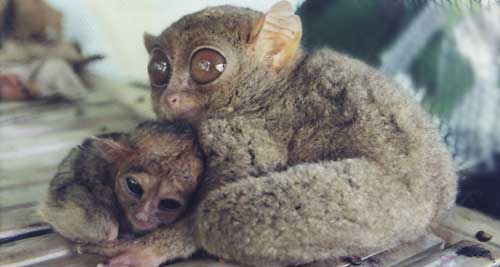Tarsier
born in captivity in Sarangani
by Rex G.
Ortega/MindaNews

MALUNGON, Sarangani
(MindaNews/6 April 2002) -- Guillermo "Jun"
Constantino caught two tarsiers and displayed them to
provincial government and tourism officials and selected
journalists at his garden home with only one goal in mind:
to prove that the endangered tarsiers exist in this part
of the country.
To his pleasant
surprise, the female tarsier took over his
"show" by adding one more cuddly tarsier for the
whole world to see.
In what must be an
historic event, a baby tarsier was born in captivity at 6
a.m. today (Saturday), stunning Constantino and the
animals' caretakers.
The Philippine
Tarsier (Tarsius syrichta) was declared on June 23, 1997
as a "specifically protected faunal species of the
Philippines" under then President Fidel Ramos'
Proclamation 1030.
The Proclamation
prohibits the hunting, killing, wounding, taking away and
possession of tarsiers and the conduct of activities
destructive of its habitats, except for "educational,
scientific, or conservation-centered research
purposes" upon certification by the Environment
Secretary.
The birth of the
baby Tarsier came exactly a week after Constantino placed
the two nocturnal creatures (head and body length around 4
to 5 inches, their tails about twice longer) inside a 1.5
foot by 2.5 foot wood and bamboo cage covered by black
nylon net.
The head and body
of the baby tarsier, whom Constantino named Tarsius Rex,
measured about 2.5 inches, its tail around 3.5 inches
long.
It came out pretty
fast with the mother tarsier delivering it in a squatting
position. Caretaker Dondon Rolion, who witnessed the birth
in its entirety, said the actual delivery took only around
three seconds.
Rolion said the
mother tarsier underwent around 30 minutes of labor
starting at 5:30 this morning (Saturday morning) when it
kept crying and making shrieking noises that sounded like
"those of a rat's."
The mother licked
the baby thoroughly and at times dunked her head into the
water container and then continued cleaning her young as
if she was washing it, Rolion said.
This supports
observations made by B'laans here that tarsiers almost
always could be found near a water source.
Constantino and
Rolion said the other smaller tarsier inside the cage
assisted in the birth by massaging the mother's belly from
behind to seemingly push the baby out.
The baby clung to
its mother whenever it moved around the cage.
A couple of hours
after the birth, the mother settled down on the floor of
the cage and just held her baby in a protective embrace.
One could almost
hear her singing a lullaby to her bundle of joy for it to
sleep. It was already 10 in the morning.
It is not certain
as yet if the Tarsiers found in Sarangani are of the same
species as Bohol's Tarsius syrichta, a subspecies of it,
or of another species found in Sulawesi, Indonesia.
There are four
known Tarsius species: Tarsius pumilus found in central
Sulawesi, Indonesia; Tarsius bancanus, found in southern
Sumatra and the nearby islands of Bangka and Belitung,
Borneo and the nearby Karimataand Serasan Islands; Tarsius
spectrum found in Sulawesi and the nearby islands of
Sangir, Peleng, and Selajar; and Tarsius Syrichta or the
Philippine Tarsier found in the islands of Samar, Leyte,
Bohol in the Visayas and Dinagat, Basilan, Siargao in
Mindanao.
Tarsiers are more
popularly thought of as existing only in Bohol. In fact,
some brochures claim Philippine tarsiers are found only in
Bohol.
But no reports of
sighting had been recorded in Mindanao in years until
early this week when the Sarangani Provincial Information
office announced that tarsiers exist in all seven towns of
this predominantly coastal province facing the Celebes
Sea.
It was news to
Sarangani officials but not to Lumads such as the B'laans
and T'bolis, who said they have long known that tarsiers,
called "mal" in their language, exist in the
province. (Rex G. Ortega/MindaNews)
|